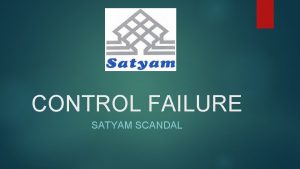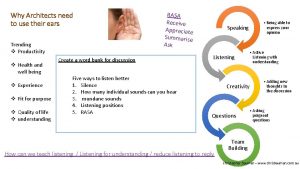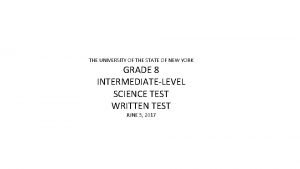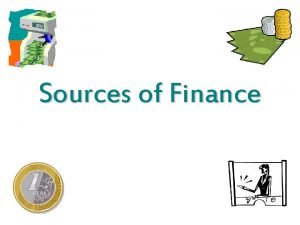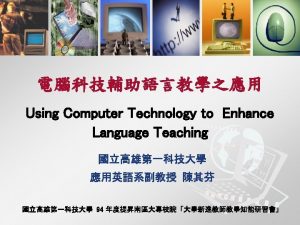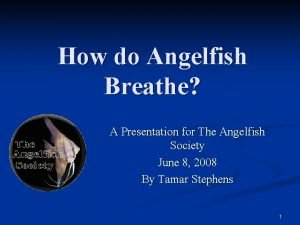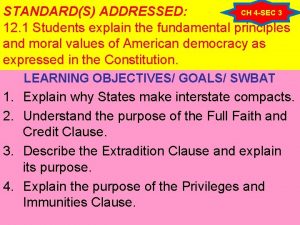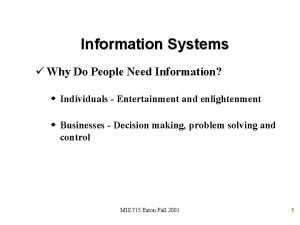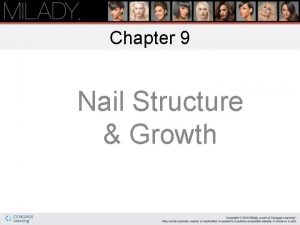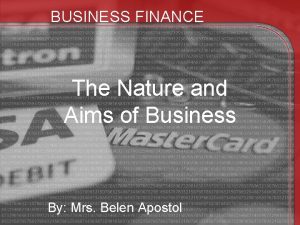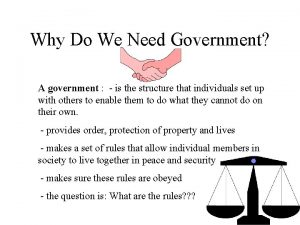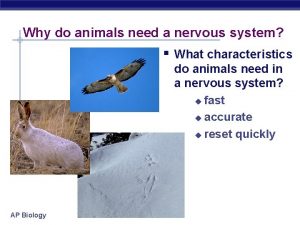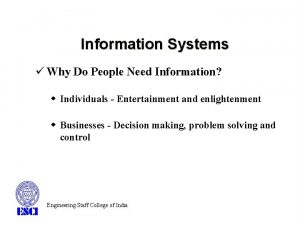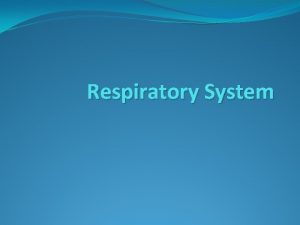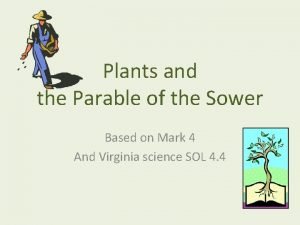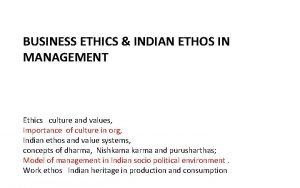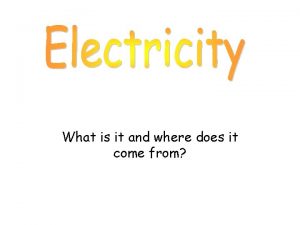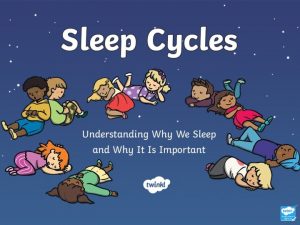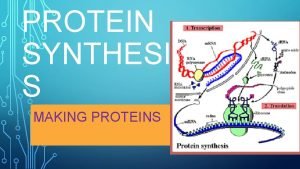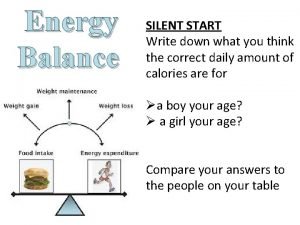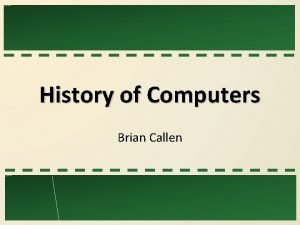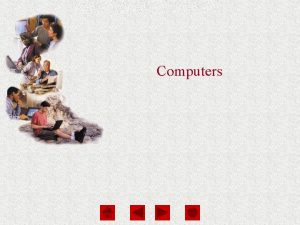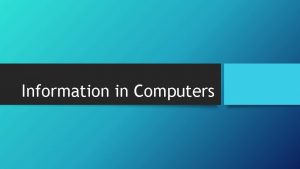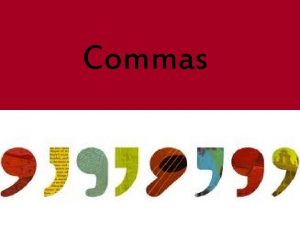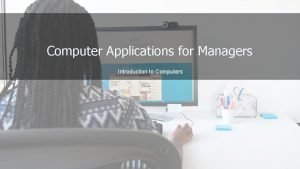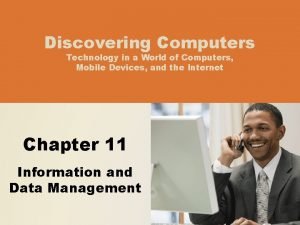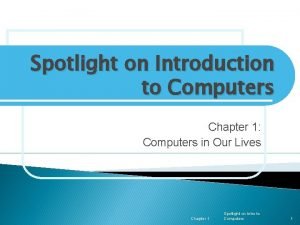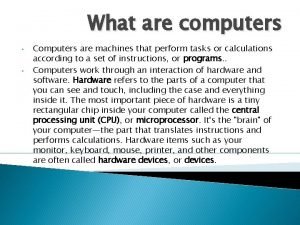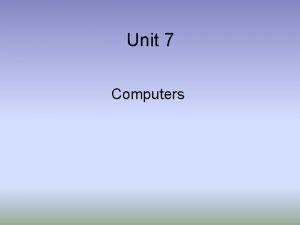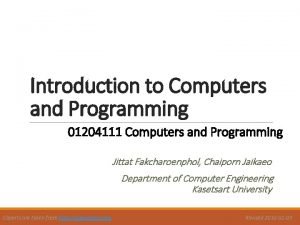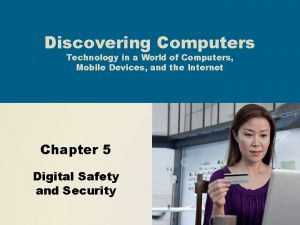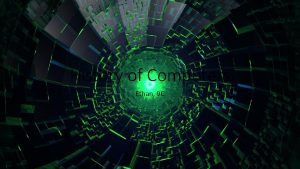Outline I Why do we need computers for








































- Slides: 40


Outline I. Why do we need computers for language teaching? II. How are computers used in language teaching contexts? III. What computer technology can be used for language teaching? IV. What knowledge and competence do language teachers need? V. Conclusion

I. Why do we need computers for language teaching? • Is the computer a must in language teaching? • The functions of computer technology for language learning • New Paradigms in Education

Is the computer a must in language teaching? • Two fallacies (Bax, 2003) 1. “Omnipotence” fallacy Computers can do everything and should replace current learning and teaching technologies. 2. “Sole Agent” fallacy The key or only factor in successful implementation of the technology is the technology itself.

Is the computer a must in language teaching? Computers CAN Computer CAN’T • Judge predetermined right-orwrong answers, e. g. , multiple choice and fill-in-the-blanks • Judge unexpected input • Provide immediate, yet fixed, feedback, suggestions, and encouragement • Provide individualized feedback beyond a predetermined list of messages • Provide authentic information through multimedia - texts, images, sounds, videos, and animations • Engage learner in rich negotiation of meaning characteristic of faceto-face interaction • Motivate task persistence • Motivate depth and quality of engagement characteristic of human interaction • Record learner’s writing, speech, and learning progress (Adapted from Meskill, 2002)

Is the computer a must in language teaching? • No, but computers will become “normalized” in everyday practice, like a pen or a book (Bax, 2003). • Computer technology has to be treated as an aid, but not a panacea. • Computer technology is neither an unalloyed blessing nor an unmitigated curse. • The effectiveness of computer use in learning and teaching does not reside in the computer technology itself but in how it is put to use and for what purposes.

The functions of computer technology for language learning Computer technology can function as • a multisensory wonderland (multiple modalities) • a reference library (rich, authentic resources) • a virtual classroom (more learning opportunities) • a meeting place (more communication opportunities) • a publishing space (sense of achievement)

New Paradigms in Education (Gubbins, Clay, & Perkins, 1999) Traditional New • lecturing on factual information • guiding, motivating, and facilitating • working as an individual • valuing working together • teacher was the primary source of knowledge • many rich sources of immediate knowledge • teacher and print media served as the primary means of communication • learning using a vast variety of media including the Internet • learning was separated from the rest of the community • learning now occurs globally

I. Why do we need computers for language teaching? Strengths of computer technology New paradigms • Multimedia • Resources • Interactivity • Flexibility • Constructivist approach in education and language teaching • Communicative language teaching

II. How are computers used in language teaching contexts? • Four Contexts and Three Roles • Locus of Control • Early CALL vs. Modern CALL (*CALL: computer assisted language learning)

Contexts & Roles for computer assisted language teaching Contexts Roles of the Computer • One-computer classroom : Tool • Computer Network room : Tutor • Self-access learning center • Distance learning : Medium

Locus of Control Locus of control: the continuum between the program’s and the learner’s responsibility for decisions about the learning outcomes, sequence of learning, learner interactions, and even content. Program User Tutorial | Games | Simulation | Experimental | Content-free | Programming games simulations tools languages (Chandler’s categories of CAI/CALL activities, 1984) Behaviorist Model (tutor) Individualism & Competitiveness The Web, CMC Constructivist Model (tool & medium) Collaboration & Negotiation

Early CALL vs. Modern CALL Early CALL Modern CALL • behaviorist approaches • communicative and socioconstructivist approaches • individualized, programmedlearning drills • collaborative, task-based activities • viewing language as discrete • viewing language as a whole components • emphasizing the importance of guidance of control • giving extrinsic feedback • giving both extrinsic and intrinsic feedback

III. What computer technology can be used for language teaching? 1) CALL-specific software and websites : Tutor 2) Generic application programs : Tool 3) Web resources and programs : Tool 4) Computer-mediated communication (CMC) programs : Medium 5) Course management systems (learning platforms) : Tutor, Tool, & Medium

1) CALL-Specific Software & Websites • Language Learning Lessons + Activities • multiple-choice & true/false quizzes • gap-filling exercises or cloze • matching • re-ordering/sequencing • crossword puzzles • games • simulations *see CD-ROM examples for language learning http: //www. ict 4 lt. org/en/en_mod 2 -2. htm#young

2) Generic Application Programs Applications designed for general purposes that can be used to support language learning, such as • word-processors (Word) • presentation software (Power. Point) • spreadsheet (Excel) • diagramming software (Visio) *Also see Microsoft Office Online Templates

3) Web Resources and Programs • Online dictionaries • Online concordancers • Reference sites (encyclopedias, e-texts, etc. ) • News/magazine sites • Web-quests • Web-publishing tools (webpages, blogs, wikis)

Online Dictionaries (1) English-English Multi-source Dictionaries • Answers. com • The. Free. Dictionary. com • One. Look Dictionary Search <http: //www. onelook. com/> • Language Tools <http: //www. itools. com/lang/>

Online Dictionaries (2) English-Chinese/Chinese-English Dictionaries • 顏元叔網路英英/英漢辭典 <http: //www. onlinedict. com/> • 淡江大學英漢/漢英線上電子字典 <http: //www. ee. tku. edu. tw/~rexchen/cdict. html> • Yahoo!奇摩英漢/漢英字典 (使用Dr. eye譯典通詞庫) <http: //tw. dictionary. yahoo. com/> • 林雨堂當代漢英詞典 <http: //humanum. arts. cuhk. edu. hk/Lexis/Lindict/> • Sino生字簿 (光華雜誌精選重要中英文辭彙,可英漢及漢英互 查,附中英文發音,特別有助於翻譯台灣本土政經及文化辭彙) <http: //www. sinorama. com. tw/ch/vocab_notebook/>

Online Concordancers (1) • What is a concordancer? A concordancer is a computer program that allows users to search a collection of authentic texts (i. e. a corpus) for multiple examples of selected words or phrases. Users can use a concordancer to find examples of authentic usage to demonstrate word collocations, word usage, or even the structure of a text. • What can teachers and learners do with concordancers? • Teachers can generate exercises (e. g. , cloze tests) based on authentic examples drawn from a variety of corpora rather than made-up ones. • Students can work out rules of grammar or usage and lexical features for themselves by searching for key words in context. This helps them to raise their language awareness, particularly in word collocations.

Online Concordancers (2) • 淡江大學 Collocation Explorer <http: //research. iwillnow. org/project/bncrce/> • 國立清華大學 CANDLE Project (NLP tools, including TOTALrecall and TANGO) , <http: //candle. cs. nthu. edu. tw/newcandle/Home_C. asp> • VLC’s Web Concordancer (Virtual Language Center of the Polytechnic University of Hong Kong) <http: //vlc. polyu. edu. hk/concordance> • Online KWIC Concordancer (a business letter corpus) <http: //ysomeya. hp. infoseek. co. jp/index. html> • Simple Search of BNC (British National Corpus) <http: //sara. natcorp. ox. ac. uk/lookup. html> • Google or other search engines

Reference Sites: Encyclopedias • Bartleby. com: Great Books Online • Encyclopedia Britannica • Columbia Encyclopedia • Encyclopedia Smithsonian • Encyclopedia. com • Wikipedia • Canadian Encyclopedia • MSN Encarta: Online Encyclopedia • Infoplease • Informationsphere • Literary Encyclopedia

Reference Sites: E-texts • • • • The World Wide School Library Online Library of Literature The Literature Network The Online Books Page by Page Books Great Books Bibliomania - Online Literature The Internet Classics Archive by MIT Project Bartleby: Great Books Online Full Text Great Literature Classics The Classical Library Classis Bookshelf Project Gutenberg Electronic Books American and English Literature Online Books

News/Magazine Sites In Taiwan • 雙語學生郵報 Bilingual Student Post • 英文中國郵報 The China Post • Taiwan News • Taipei Times • ICRT EZ News • 民視英語新聞 • 光華雙語雜誌 Sinorama • News Talk 新聞脫口秀 • 行政院新聞局英文網站(英文時事 新聞) In the U. S. or U. K. • BBC News • • • • BBC Learning English CNN News CNN Student News Discovery. com Newsweek National Geographic Public Broadcasting Service (PBS) Reader's Digest Time Magazine online edition The New York Times USA Today US News and World Reports Voice of America - Special English Washington Post

Web-Quests (1) • A Web. Quest is an inquiry-oriented activity in which most or all of the information used by learners is drawn from the Web. • Web. Quests are designed to use learners' time well, to focus on using information rather than looking for it, and to support learners' thinking at the levels of analysis, synthesis and evaluation. • A Web. Quest usually includes the following elements: • An introduction or scenario • A task that is meaningful and doable • A process for completing the task • Information resources to support the task • A conclusion that brings closure and evaluation

Web-Quests (2) • The use of Web. Quests facilitates collaborative learning, offers different kinds of resources, develops thinking skills, and provides a variety of ways to access and construct knowledge. • Examples: • Charlotte’s Web. Quest <http: //www. bgcs. k 12. oh. us/kramp/Charlott'e%20 Web. htm> • Grammar without the pain by Ms. Carino <http: //www. berksiu. k 12. pa. us/webquest/carlino/index. htm> • Track. Star (developed by the University of Kansas) <http: //trackstar. 4 teachers. org/trackstar/> - Track # 126807 New York, New York

Web Publishing Tools • Webpages • Track. Star (http: //trackstar. 4 teachers. org/trackstar/) • Web Worksheet Wizard (http: //wizard. 4 teachers. org/) • Project Poster (http: //poster. 4 teachers. org/) ( * The above three are all provided by the University of Kansas http: //4 teachers. org/) • Tripod site builder / Yahoo! Site. Builder • Blogs • My students’ examples <http: //www 2. nkfust. edu. tw/~emchen/CALL/student_blog. htm> • Wikis (for e-portfolio or collaborative projects) • Seedwiki http: //www. seedwiki. com/ • Schtuff http: //www. schtuff. com/ • Jotspot http: //www. jot. com/index. php

4) CMC Programs Synchronous: Asynchronous: Online Chat Room Email / Discussion Forum • Dave’s ESL Cafe's Chat Central • Dave's ESL Cafe: • ESL Chat Room in English. Club. com 2) Teacher Discussion Forums • Chat Room in Englishbaby. com • VLC Chat Rooms (Hong Kong) 1) Student Discussion Forums • BBC Learning English – Communicate • English. Club. com ESL Forums • Nicenet. org

Possible Uses of Asynchronous Discussion 1. Exchange of ideas and perspectives 2. Reflective conversation 3. Debate on controversial issues 4. Peer review of assignments 5. Presentation of text-based works

Strengths of Using Asynchronous Discussion 1. Extending classroom discussions 2. Providing a less intimidating environment 3. Allowing everyone’s voice to be heard 4. Supporting collaborative learning 5. Encouraging reflective learning and critical thinking 6. Promoting more careful deliberation over course content 7. Gaining multiple perspectives 8. Increasing the use of the target language 9. Recording and storing all discussions

Constraints of Using Asynchronous Discussion 1. Extra time needed for both students and the teacher 2. Text based interaction only and lack of non-verbal communication 3. No guarantee for immediate feedback 4. Lack of spontaneous exchange of ideas 5. Students’ language proficiency, attitudes, peer interaction can affect the quantity and quality of discussion 6. The design of discussion questions and activities can affect the willingness of student participation

Tips to Implement Asynchronous Discussion Activities 1. Require participation and include a grade for participation. 2. Divide the class into small groups for discussion. 3. Clearly define tasks, expectations, and deadlines. 4. Make the discussion questions interesting, meaningful, and purposeful. 5. Make sure discussions are of a long enough duration to allow full and thoughtful participation. 6. Refer to students’ discussions often in class and help them to see the value of online discussions. 7. Encourage students to ask questions to each other, so that more responses can be elicited.

5) Course Management System (Learning Platform) • A Course Management System (CMS) is a software system designed to facilitate teachers in the management of online learning courses for their students. • These services generally include access control, delivery and management of course content, communication tools, quiz functions, and administration of user groups. • The functions of CMS: tool + tutor + medium • Similar Terms: also called Virtual Learning Environment (VLE), Learning Management System (LMS), Learning Support System (LSS), or Learning Platform.

5) Course Management System • Three uses of CMS in educational contexts • Standalone Online Course − predominantly in the distance learning sector − separation of place and/or time • Compliment (Enhanced) Course − enhance the traditional face-to-face course − does not reduce contact time • Supplement (Hybrid / Blended) Course − “fill in” or complete the face-to-face course − reducing the time dependency

Online Lesson Design Content Design Visual Design • Presentation • • • Conciseness Comprehensibility Accuracy Good organization Interestingness • Interaction • • Inquiry-based Task-based Emphasis on Collaboration Immediate feedback • Consistency • Legibility • Good use of space • Careful use of color • Alignment & proximity • Well-designed tables, charts, and figures • easy and clear navigation • Small file size

Lessons Learned from Research • The online environment is not conducive to lecturing and this should be avoided in static information displays. • Take advantage of the interactive environment to produce engagement. • Collaborative learning groups appear to be both effective and efficient. • Student satisfaction appears to be best when utilizing team projects that focus on critical thinking and real-life problem solving skills. • The Key to learning is the ability to provide periodic graded self-assessments of the individual’s knowledge base with immediate feedback in both performance and areas of deficits.

IV. Knowledge and competence language teachers need Second Language Acquisition Language Teaching Methods Tool Literacies • computer literacy CALL Literacies of Representation • network literacy • information literacy • technology literacy • media literacy Electronic Literacy • Communication • Construction • Research (Shetzer & Warschauer, 2000) • Visual literacy (Tyner, K. 1998, Digital Literacy)

IV. Knowledge and competence language teachers need • Electronic literacy (Shetzer & Warschauer, 2000) • Communication: how to express and interpret meaning in the computermediated communication environment • Construction: how to write 1) from essay to hypertext, 2) from words to multimedia, and 3) from author to co-constructor • Research: how to navigate Web sources, search for information, and evaluate and interpret the found information

V. Conclusion • “What is the use of a book, ” thought Alice, “without pictures or conversation? ” ~ From Alice's Adventures In Wonderland (p. 1) • Pedagogy must drive the choices of instructional technology, not the other way around (Chizmar & Walbert, 1999) • The effectiveness of computer-assisted language learning and teaching resides in how the computer is put to use and for what purposes it is used. The true creativeness of a learning/teaching activity must come from the pedagogical side.

If knowledge is worth having, it is worth sharing. ~ Deborah Cameron 敬請指教,謝謝 ! 陳其芬 Dr. Chi-Fen Emily Chen 國立高雄第一科技大學 應用英語系副教授 Website: http: //www 2. nkfust. edu. tw/~emchen/Home Email: emchen@ccms. nkfust. edu. tw Phone: 07 -601 -1000 ext 5118
 Pictures
Pictures Why satyam computers failed
Why satyam computers failed Don't ask why why why
Don't ask why why why Quote sandwich
Quote sandwich Why architects need to use their ears
Why architects need to use their ears Shylock speech
Shylock speech Three living organisms
Three living organisms Why do we need to breathe
Why do we need to breathe Why do businesses need finance
Why do businesses need finance Why we need computer
Why we need computer Lamillae
Lamillae Why do we need arrays?
Why do we need arrays? No state can make unreasonable distinctions
No state can make unreasonable distinctions Why cells need energy
Why cells need energy Aerobic vs anaerobic respiration
Aerobic vs anaerobic respiration Agility in table tennis
Agility in table tennis We need to water
We need to water Why do all organisms need nitrogen
Why do all organisms need nitrogen Why do people need information
Why do people need information Why do we need cracking
Why do we need cracking Growth
Growth Nature and aims of business
Nature and aims of business Why do all organisms need food
Why do all organisms need food Why do we need a government
Why do we need a government Why do animals need a nervous system
Why do animals need a nervous system Different method of size separation or
Different method of size separation or Why do people need information
Why do people need information Why do cells need oxygen?
Why do cells need oxygen? Plants
Plants Elements of indian ethos
Elements of indian ethos Why we need electricity
Why we need electricity Why we need sleep
Why we need sleep Why do we need cells
Why do we need cells Why do we need food
Why do we need food Jill is climbing where does she need high friction
Jill is climbing where does she need high friction Why we need food
Why we need food Why do we need weather
Why do we need weather Formuö
Formuö Typiska novell drag
Typiska novell drag Nationell inriktning för artificiell intelligens
Nationell inriktning för artificiell intelligens Vad står k.r.å.k.a.n för
Vad står k.r.å.k.a.n för

